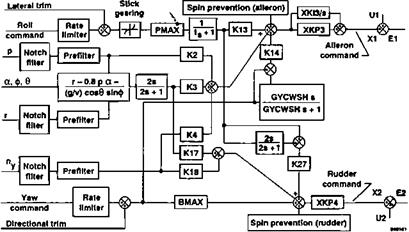Command Augmentation Systems
Command augmentation systems, or CAS, are a relatively recent form of airplane stability augmentation. Pilot control inputs, usually filtered or shaped, are compared with measured airplane motions, with the differences being sent to the control surface actuation servos (Figure 20.3). In early command augmentation applications, such as in the McDonnell Douglas F-4, F-15, and F-18 and the Rockwell B-1, the augmentation system has limited authority. There are parallel direct links from the sticks to the control surface servos.
|
Figure 20.3 Block diagram for the lateral-directional command augmentation system for the X-29A research airplane. Key features are the rate-limiters on roll and yaw commands. These minimize the possibility of rate-limiting the control servos due to large pilot control inputs. (From Clarke, Burken, Bosworth, and Bauer, NASA TM 4598, 1994) |
The command augmentation systems of later airplanes such as the fly-by-wire General Dynamics F-16 have full-authority and high-command gains. Full-authority roll command augmentation systems have worked very well, with sharp, rapid, and precise responses to control inputs (Mitchell and Hoh, 1984). Some problems come along with these successes. Oversensitivity to small inputs, overcontrol with large inputs, and the phenomenon called roll-ratcheting can occur.















